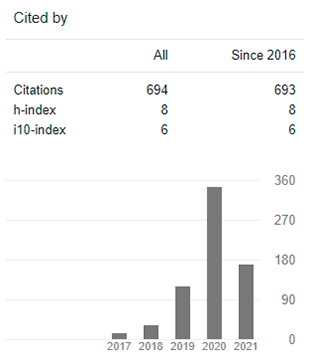Strengthening of Environmental Education Through the Planting of Ornamental Plants
DOI:
https://doi.org/10.29394/Scientific.issn.2542-2987.2018.3.7.16.309-328Keywords:
environmental education, plants, natural resourcesAbstract
The purpose of this research work is to develop ornamentation and afforestation activities to strengthen Environmental Education in the Sector 3 de Mayo. In Ciudad Bolivia, Pedraza Municipality, Barinas State. This work framed the qualitative paradigm supported by an action research. The key informants were represented in three May 3 sector inhabitants who with the characteristic of being active members of the Local Council of the locality: (1) one belonging to the education committee, (1) one that is part of the urban land committee and rural and (1) one member of the health committee. It was determined that the inhabitants of the community do not encourage activities of beautification and environmental awareness. The technique used to collect information was the interview, applying a contention script of (5) five open-ended questions related to the subject matter. Within the informants' testimonies the following findings were found, interviewees said that they lack training in relation to the subject of ornamentation and maintenance of green areas. Situation that requires the development of an action plan of ornamentation and afforestation to strengthen environmental education in the community.
Downloads
References
Bavaresco, A. (2013). Proceso metodológico en la investigación. Cómo hacer un Diseño de Investigación. Maracaibo, Venezuela: Editorial de la Universidad del Zulia.
Barros, A. (2013a,b). Geografía / Polimodal. Recursos naturales y ambientes en un mundo global. Buenos Aires: Longseller.
Chadwick, C. (1999). La psicología del aprendizaje desde el enfoque constructivista. Revista Latinoamericana de Psicología, vol. 31, núm. 3, 1999, págs. 463-475.
Contreras, J. (2016). Estrategias Ambientales para la Conservación del Bosque La Ciénaga, Ubicada en la Parroquia Barrancas, Municipio Cruz Paredes del Estado Barinas. Revista Scientific, 1(1), 72-89. Recuperado de: https://doi.org/10.29394/scientific.issn.2542-2987.2016.1.1.5.72-89
Fernández, H. (2014a,b). Los valores ambientales en los procesos educativos Realidades y Desafío. Revista Iberoamericana sobre Calidad, Eficacia y Cambio en Educación. Volumen 7, Número 2. Rinace.
Hitcher, H. (2013). Enfoques y Principios Teóricos de la Teoría Humanista, Social y Cultural. Curso Básico para la formación de docentes. México: Editorial Trillas.
Hurtado I., & Toro J. (2005a,b,c). Paradigmas y Métodos de Investigación en Tiempos de Cambio. 5ta Edición. Venezuela: Espíteme C.A. Recuperado de: https://es.slideshare.net/aliriotua/paradigmas-y-metodos-de-investigacion-autores-ivn-hurtado-len-y-josefina-toro-garrido
Informe 21 (2013). Se habla mucho de él, pero… ¿Qué es el Protocolo de Kioto? Noticias en Línea. Recuperado de: https://informe21.com/ciencia-y-tecnologia/se-habla-mucho-de-el-pero-%C2%BFque-es-el-protocolo-de-kioto
León, C. (2013). Tutela Ambiental. Caracas, Venezuela: Ediciones Paredes.
Martínez, C. (2013). Valoración de áreas verdes urbanas de uso público en la comuna la Reina. Santiago: Universidad de Chile.
Montaldo, A. (2013). La Formación de valores Ambientales en la Revolución Cubana Un reto de hoy. Ponencia. La Habana, Cuba: Reunión de investigadores de la juventud.
Nebel, J. & Wright, E. (2013). Qué es la Agenda 21. Recuperado de: http://www.ecologiaverde.com/que-es-la-agenda-21/
Red Voltaire (2006). Manifiesto de las Américas: en Defensa de la Naturaleza y la Diversidad Biológica y Cultural. Oficina Regional para América Latina y el Caribe. Página web en línea. Recuperado de: http://www.voltairenet.org/article138190.html
Sánchez, A. (2012). Plantas Ornamentales. Consejo Argentino para la Información y Desarrollo de la Biotecnología.
Sepúlveda, M. (2013). Educación Ambiental e intervención socio comunitaria. Universidad de las islas Baleares.
Tamayo & Tamayo (2013a,b). El proceso de la Investigación científica. 4ta Edición. Limusa Noriega.
Urrea, R. (2016). Formación para la disminución de residuos sólidos, en la Escuela Básica Bolivariana “Ana de Romero”. Revista Scientific, 1(1), 150-168. Recuperado de: https://doi.org/10.29394/scientific.issn.2542-2987.2016.1.1.9.150-168
Zapata, D. (2006). Restauración de la Plaza “Delia Ávila de Zapata”. Estado Sucre. Recuperado de: http://www.monografias.com/trabajos35/plaza-avila-zapata/plaza-avila-zapata.shtml
Published
How to Cite
Issue
Section
License
Copyright (c) 2018 INDTEC, C.A.

This work is licensed under a Creative Commons Attribution-NonCommercial-ShareAlike 4.0 International License.
The content of the journals of this site, are under a Creative Commons Attribution-Noncommercial-Share Alike 4.0 International License.













